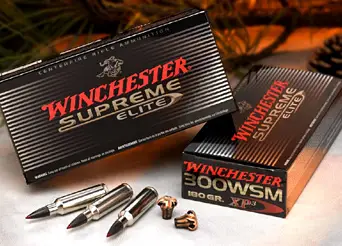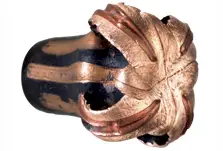|
NEW: Winchester Supreme Elite XP3 By Chuck Hawks with Bob Fleck and Nathan Rauzon  Winchester's latest Supreme ammunition, packaged in an embossed black and gold box, is dubbed "Supreme Elite." The word "Winchester" is printed in red, "Supreme" is printed in gold, and "Elite" is printed in silver! The name may be a little redundant, but the new box is striking and the ammo inside is pretty neat, too. It is loaded with Winchester's new XP3 bullet, which will eventually replace the very tough (sometimes too tough!) Fail Safe bullet in Winchester Supreme rifle ammunition. My guess is that the XP3 will eventually also largely replace the CT Partition Gold bullet in rifle ammo, although there is no official word from Winchester to that effect at the time of this writing. The XP3 incorporates several popular bullet design features. These include a translucent red polycarbonate tip that resists deformation in the magazine and improves the ballistic coefficient, as does the new bullet's boat-tail heel shape. The plastic tip also initiates the expansion of the bullet by driving down into the front cavity on impact and splitting open the front of the bullet, much like the new Barnes MRX bullet, which in some respects is a similar (but independent) approach to bullet design.  The front half of the XP3 bullet body is lead free, being made of solid gilding metal (a copper alloy that avoids the copper fouling problem inherent in pure copper bullets). The back half has a conventional lead core similar to the rear core of a Nosler Partition bullet. Unlike a Nosler Partition (but like a Swift A-Frame) the rear lead core is bonded to the outer gilding metal jacket. The general effect is sort of like grafting the back half of a Nosler Partition bullet to the front half of a Barnes MRX bullet. As a finishing touch, the bullet receives Winchester's proprietary Lubalox black coating to reduce engraving force and barrel fouling. Like other Winchester Supreme rifle ammunition, the brass case (but not the Winchester primer) is nickel plated for corrosion resistance. The visual effect of this cartridge with its translucent red-tipped black bullet in the silver case with a brass primer is striking. The XP3 is a more sophisticated design than the previous CT Fail Safe. It is intended to begin expansion against lower resistance, making it a better bullet for deer and CXP2 game as well as entirely suitable for elk and CXP3 game. It is understood by experienced hunters and experimenters that some, perhaps most, premium controlled expansion bullets over emphasize deep penetration and weight retention (the big selling point in bullets today). The result is that they do not expand rapidly enough to insure quick kills on light framed animals such as deer and pronghorn antelope. Such animals may run a long way before finally collapsing, even though fatally struck by one of these very tough bullets. The XP3 bullet's polycarbonate tip is designed to alleviate that problem by rapidly initiating expansion. The steel insert used in the lead cored shank of the previous Fail Safe and Partition Gold bullets is gone. Now the back half of the bullet is allowed to bulge (but not break-up), much like a standard Nosler Partition bullet. This helps to support the front mushroom and enlarge the crush cavity of the wound. Winchester calls this "2-stage expansion."  Getting rid of the front lead core and the rear core steel inserts and using a simple cylindrical rear lead core reduces the internal complexity of the XP3, making it easier to mass produce to high standards of accuracy than either the Fail Safe or Partition Gold. I, like many other shooters, have noticed that complex bullets are often the least accurate. For uniformity and accuracy in bullets, simple is usually better. The new XP3 bullet is available for 2006 in the following calibers and bullet weights: .270 Win./150 grain, .270 WSM/150 grain, 7mm WSM/160 grain, 7mm Rem. Mag./160 grain, .308 Win./150 grain, .30-06/150 and 180 grain, .300 WSM 150 and 180 grain, .300 Win. Mag. 150 and 180 grain. It is expected that more calibers and bullet weights will be added if the XP3 is a commercial success. 7mm/140 grain, .338/225 grain and .375/300 grain would seem to be obvious future possibilities. Winchester supplied sample Supreme Elite ammunition with the new XP3 bullet to Guns and Shooting Online in .308 Winchester/150 grain (stock # SXP308) and .270 Winchester/150 grain (stock # SXP270W) calibers. The sectional density (SD) of all .308"/150 grain bullets is .226, while the SD of all .277"/150 grain bullets is .279. Winchester recommends these loads for both CXP2 and CXP3 game. Winchester catalog ballistics for the .308 load claim a muzzle velocity (MV) of 2825 fps and muzzle energy of 2658 ft. lbs. from a 24" test barrel. Down range velocity and energy figures are: 2616 fps/2279 ft. lbs. at 100 yards, 2417 fps/1945 ft. lbs. at 200 yards, 2226 fps/1650 ft. lbs. at 300 yards, and 2044 fps/1392 ft. lbs. at 400 yards. The Winchester trajectory figures printed on the box for that load are based on a 200 yard zero with a scope line of sight 1.5" over the axis of the bore and look like this: +1.8" at 100 yards, 0 at 200 yards, -7.8" at 300 yards, and -22.6" at 400 yards. Winchester ballistics for the .270 load claim a muzzle velocity (MV) of 2950 fps and muzzle energy of 2705 ft. lbs. from a 24" test barrel. Down range velocity figures are: 2763 fps at 100 yards, 2583 fps at 200 yards, 2411 fps at 300 yards, and 2245 fps at 400 yards. The Winchester trajectory figures for that load are based on a 200 yard zero and look like this: +1.5" at 100 yards, 0 at 200 yards, -6.7" at 300 yards, and -19.5" at 400 yards. Guns and Shooting Online staff members Bob Fleck and Nathan Rauzon helped me with the shooting chores. In .308 Winchester caliber we used Bob's Winchester Model 100 autoloading rifle and my Ruger Model 77RSI bolt action, and in .270 Winchester caliber we used Nate's Ruger No. 1B falling block rifle and my custom Mauser 98 built by Larry Brace. The Winchester Model 100 is a pre-1964 vintage, gas operated, semi-automatic hunting rifle with a one-piece stock and a 22" medium contour barrel. It wears a Bushnell Trophy 3-9x40mm scope in Bushnell bases and rings. My .308 Ruger M77RSI bolt action carbine wears a Leupold Vari-X 2-7x Compact scope in Ruger rings. The single shot Ruger No. 1B wears a Weaver Grand Slam 3-10x40mm scope in Ruger rings. The Custom built Model 98 bolt action wears a Leupold VX-III 2.5-8x36mm scope in a one-piece Leupold base and rings. We did our ammo testing at the Isaac Walton gun range south of Eugene, Oregon over two range sessions. This outdoor facility offers covered bench rests and target stands at 25, 50, 100, and 200 yards. We did our shooting for record at a distance of 100 yards. All groups were 3 shots and fired on Hoppe's "Crosshair" targets from a Caldwell Lead Sled rest weighted with 50 pounds of lead shot. We allowed the rifles' barrels to cool between groups. The autumn weather was typically variable, with an ambient temperature of about 70 degrees F during our first range session and a cool 50 degrees F during our second session. On both days we had a shifty, moderate breeze that probably didn't have much effect on high velocity 150 grain bullets fired at targets only 100 yards distant. For "control" (or comparison) loads in .308 we shot some groups with Stars and Stripes Match ammunition using 170 grain Lapua FMJ-BT bullets loaded with great care in Lapua brass. We also shot some standard Remington Express 150 grain Core-Lokt Pointed Soft Point factory loads. In .270 our control ammo was the Winchester Super-X 130 grain Power Point factory load. Here are the shooting results from the .308 Winchester Model 100:
Here are the shooting results from the .308 Ruger M77RSI:
Here are the shooting results from the .270 Ruger No. 1B:
Here are the shooting results from the .270 Mauser 90 Custom:
Frankly, we are not sure what conclusions, if any, should be drawn from these results. Perhaps the best conclusion is, as always, to try the ammunition yourself and see how it shoots in your rifle! As you can see from the summary above, in .308 the Stars and Stripes and Remington factory loads gave us typical and reasonably consistent results from both rifles, while the Winchester Supreme Elite XP3 load produced greater variation in group size. Sometimes we got tighter than usual groups from this ammo, and sometimes we got larger groups than expected. The story was similar in .270, where the Winchester Super-X load shot groups that we consider typical from both rifles, while the new Supreme Elite load performed more erratically. We'd blame ourselves (after all, we are far from perfect marksmen), but three shooters and four rifles in two calibers all produced similar results.
One possible explanation for the variation in XP3 group sizes might be the Lubalox coating on the bullets. I shoot Lubalox coated CT 95 grain Ballistic Silvertip bullets as well as standard Nosler 95 grain Ballistic Tip bullets in my Browning .243 rifle with no problems and equally outstanding results. But none of our available test rifles in .308 or .270 are normally used with coated bullets, and that may have been a factor. Remember, too, that the groups recorded above were adequate to kill any deer or elk that walks on this earth very dead at normal ranges. Certainly the new XP3 bullet is a positive step toward correcting the problems relating to slow expansion encountered with the earlier Fail Safe bullet. From what we could tell, the XP3 bullet's terminal performance is pretty much as advertised, making it one of the top choices for combined CXP2/CXP3 game hunts. |